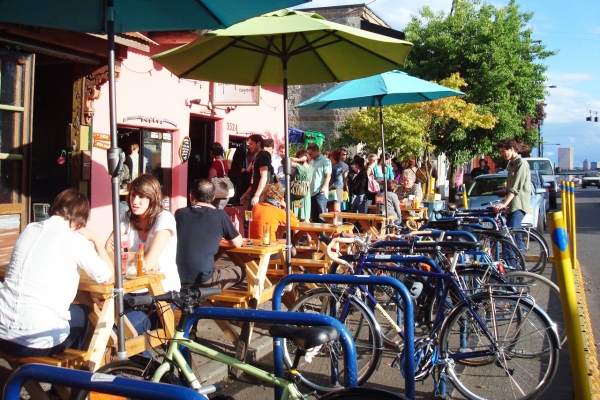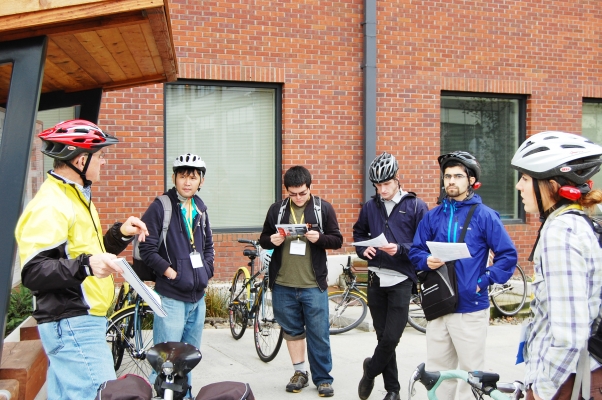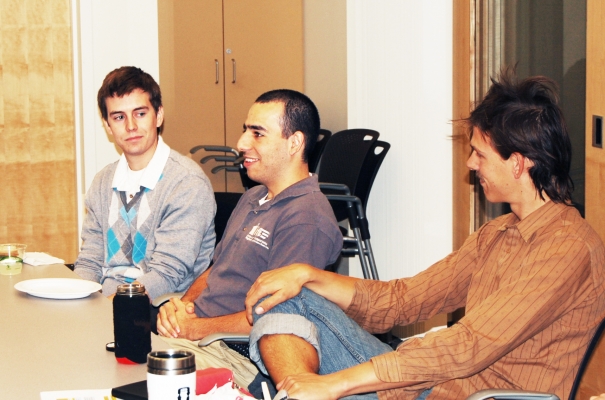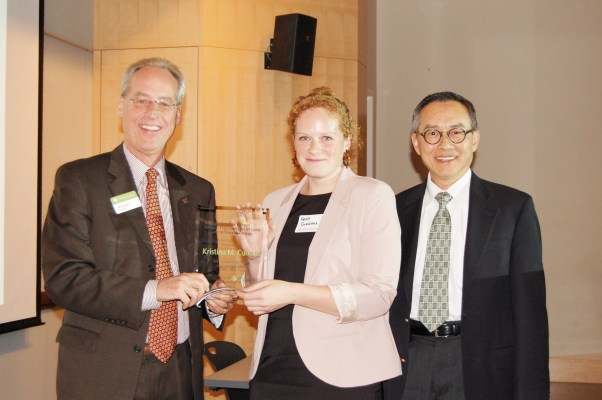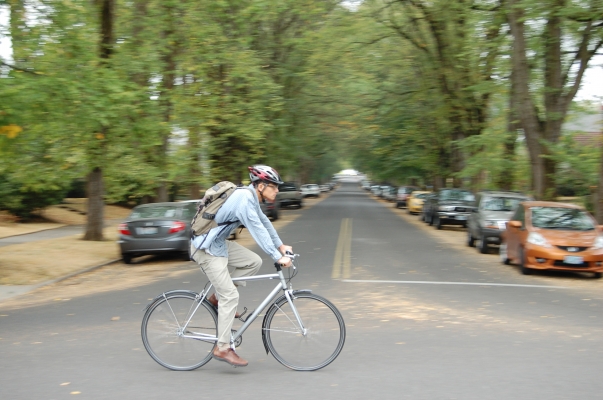PSU’s Students in Transportation Engineering and Planning (STEP) hosted the 10th Annual Region X Conference on November 16, and it was the most widely-attended Region X event in recent memory. With participating universities including Oregon State University, Cal Poly Pomona, University of Oregon, University of Utah, University of Washington and Washington State University, the more than 100 registrants “really surprised” STEP President S. R. Thompson. “The turnout was high compared to previous years.” This is likely in part due to the first-time participation of the two Washington schools.
This year’s conference featured student research presentations and a poster session, as well as three afternoon breakout sessions that offered tours of effective transportation engineering examples in the Portland Metro area. Thompson reports a unanimously positive response to the breakout sessions from those tour participants who followed up with her after the conference adjourned.
The conference’s morning keynote was also popular and garnered plenty of student participation in the discussion that followed. “We did things a little differently for the keynote presentation this year,” Thompson said. The presentation featured a panel of notable transportation professionals from the Portland area who each discussed their respective entries into the transportation field as well as the joys and challenges of the work.
"We were lucky in terms of our panel...
Read moreWhile the annual Region X Student Transportation Conference in November always attracts students from across the northwest, this year’s conference pulled some from much farther south: Pomona, Calif.
The conference is a showcase for student transportation research in the Pacific Northwest (Federal Region X), which includes Washington, Oregon, Idaho, and Alaska. Region X serves as a microcosm of transportation for the entire country, making it a prime testing ground for studies in transportation operations and planning.
The conference was sponsored by OTREC and hosted this year by Students in Transportation Engineering and Planning (STEP), the Portland State University Student Chapter of ITE.
When professor Xudong Jia of Cal Poly Pomona learned about the conference, he was determined that his students would find a way to attend. With the support of OTREC, Cal Poly Pomona sent five students to the conference, a mix of undergraduate and graduate students in civil and transportation engineering. The students were interested in both the research and tours, as well as gleaning tips for how to organize a student-led conference: something the Cal Poly students will be doing when they host the TransModal Connection Conference in February in San Louis Obispo.
In addition to visiting the Western Federal Lands Materials lab in Vancouver, Wash., the team competed in the Oregon Section ITE William C. Kloos Traffic Bowl. Though a transportation mishap left them...
Read morePortland State University inducted graduate student Kristina Currans into the Denice Dee Denton Women Engineers Hall of Fame in a ceremony Nov. 15. Currans is the second transportation engineering student to win the student award.
Maria Klawe, president of Harvey Mudd College, took the Outstanding Female Engineer honors.
Currans’ boundless enthusiasm and dedication to her work quickly become apparent to anyone who works with her, said Kelly Clifton, an associate professor of civil engineering and director of the Oregon Modeling Collaborative. “I’ve never met someone able to manage so many things,” said Clifton, who nominated Currans for the honor.
Currans works with Clifton as a part of the Oregon Modeling Collaborative and on several OTREC research projects. “She brings a tremendous amount of energy,” Clifton said.
After graduating Oregon State University with a civil engineering bachelor’s degree in 2010, Currans soon made a name for herself in transportation circles. She started her graduate coursework at Portland State and worked during academic breaks with the Oregon Department of Transportation’s Transportation Planning Analysis Unit, home to state and regional transportation models.
“For someone who had just graduated with an undergraduate degree, she completed that internship and really impressed ODOT,” Clifton said. “To do that so quickly caught everyone’s attention.”
Currans tested and worked with the Statewide Integrated...
Read moreThe Oregon Transportation Research and Education Consortium is pleased to announce the members of the Board of Advisers for its newest program, the National Institute for Transportation and Communities. The Board is scheduled to meet for the first time in late November 2012.
The USDOT’s Research and Innovative Technology Administration (RITA) 7th Annual UTC Spotlight Conference on Sustainable Energy and Transportation: Strategies, Research, and Data was held on November 8-9 in Washington, DC and featured OTREC energy related research from Portland State University and Oregon State University. This year’s conference focused on promoting dialogue and coordination among University Transportation Centers (UTCs), federal agencies, industry, and state and local agencies on research to address the complex and challenging issues concerning sustainable energy and transportation. The plenary and breakout sessions focused on research to improve energy efficiency, reduce dependence on fossil fuels, and identify of effective strategies to promote USDOT's strategic goals. As the U.S. moves toward a performance-based transportation bill, energy-focused environmental sustainability is expected to become one of the pillars against which success is measured if it is to become a national priority.
Dr. B. Starr McMullen, Oregon State University, took part on a plenary panel discussion on the interconnection of energy use, pricing and finance and highlighted two OTREC funded projects The Relationship Between VMT and Economic...
Read moreThe Oregon Transportation Research and Education Consortium (OTREC) and National Institute for Transportation and Communities (NITC) are offering a number of doctoral dissertation fellowships of up to $15,000 per successful candidate. Fellowships will be awarded to cover expenses for the recipient while working on the dissertation. The funded dissertation research must be on surface transportation topics that fit under the OTREC theme of advanced technology, integration of land use and transportation or healthy communities or NITC theme of safe, healthy, and sustainable transportation choices to foster livable communities. Priority will be given to topics with a sustainable transportation focus. The deadline for applications is December 31, 2012.
ELIGIBILITY
Students must be a US Citizen and have advanced to candidacy for the Ph.D. degree prior to the application deadline.
OTREC fellowships are open to students currently enrolled in a transportation-related doctoral program at Portland State University (PSU), University of Oregon (UO), Oregon State University (OSU), Oregon Institute of Technology (OIT).
NITC fellowships are open to students currently enrolled in a transportation-related doctoral program at Portland State University (PSU), University of Oregon (UO), Oregon Institute of Technology (OIT), or the University of Utah (UU).
PROCESS
Applicants must submit...
Read morePostdoctoral candidates Joseph Broach and Arlie Adkins (both at Portland State University) were recently awarded $15,000 fellowships to assist them in completing their dissertation research. They were awarded the fellowships through an open and competitive process available to PhD candidates at Oregon State University, University of Oregon, Oregon Tech, Portland State University and the University of Utah.
Joseph's research will explore a travel mode choice framework incorporating realistic bike and walk routes. His research will consider a more complete mode choice behavioral framework that acknowledges the importance of attributes along the specific walk and bike routes that travelers are likely to consider. The proposed framework will then be applied to revealed preference travel datasets collected in Portland, Oregon. Measurement of nonmotorized trip distance/time, built environment, trip/tour, and attitude attributes as well as mode availability and model structure will be addressed explicitly. Route and mode choice models will be specified using discrete choice techniques.
He moved to Portland in 2006 after completing a B.A. in Liberal Studies and M.A. in Economics at the University of Montana. Lifelong interests in transportation and how people make decisions led him to the Urban Studies PhD program at PSU. During his time here, Joe has worked on a number of research projects related to transportation data and modeling: ...
Read moreThis fall, the Friday transportation seminar series at Portland State University has focused on data collection and how information is used to make transportation investments. The Oct. 26 seminar, with the University of Minnesota’s Greg Lindsey, covered tracking and modeling travel behavior.
Engineers and planners alike have relied on traffic counts for their traffic models, but data behind bike and pedestrian travel has been fuzzy. Now, researchers such as Lindsey are offering new methods for conducting bike and pedestrian counts on trails and multiuse paths.
With little guidance from the Federal Highway Administration, Lindsey said, most of the efforts in creating best practices have bubbled up from communities like the Twin Cities, chosen as Nonmotorized Transportation Pilot Cities. Lindsey and his researchers monitored six trails in Minneapolis, using inductive loops and infrared beams.
To address calibration problems and offer validity to their field numbers, Lindsey also sent students into the field to verify counts. The technology allowed for finer-grained detail, especially over a 24-hour period. OTREC Director Jennifer Dill noted, “Too much in the past we’ve lumped “bike and peds” together and your work and analysis is demonstrating that they truly are different modes, with different behaviors.”
Lindsey stressed the importance of conducting this type of research, and measuring our “bicycle miles traveled” and “pedestrian miles traveled” in...
Read moreWhen policymakers look to meet cycling goals by investing in new bicycle routes, they have little research to help them determine whether cyclists will actually use them. As a result, bicycle facilities aren’t considered equally with motor vehicle infrastructure.
That’s changing, thanks in part to OTREC research. An OTREC-funded study, the first to gather large-scale data that reveal cyclists’ actual route preference, is being published in a scientific journal (Transportation Research Part A). The findings have already been incorporated into the regional travel demand model used to make transportation investment decisions across the Portland region.
In the study, Portland State University researchers Joseph Broach, Jennifer Dill and John Gliebe (Gliebe is now with RSG Inc.) outfitted cyclists with GPS units to record which routes they chose and model the choices to reveal preferences. Previous studies have relied on stated preference surveys or less reliable methods of determining cyclists’ actual routes. The data gathering was supported by a grant from the Robert Wood Johnson Foundation through its national...
Read more
